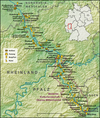
Bacharach is a town in the Mainz-Bingen district in Rhineland-Palatinate, Germany. It belongs to the Verbandsgemeinde of Rhein-Nahe, whose seat is in Bingen am Rhein, although that town is not within its bounds.

Bingen am Rhein is a town in the Mainz-Bingen district in Rhineland-Palatinate, Germany.

The Rhine Gorge is a popular name for the Upper Middle Rhine Valley, a 65 km (40 mi) section of the Rhine between Koblenz and Rüdesheim in the states of Rhineland-Palatinate and Hesse in Germany. It was added to the UNESCO list of World Heritage Sites in June 2002 because of its beauty as a cultural landscape, its importance as a route of transport across Europe, and the unique adaptations of the buildings and terraces to the steep slopes of the gorge.

Rüdesheim am Rhein is a German winemaking town in the Rhine Gorge, and part of the UNESCO World Heritage Site in this region. It lies in the Rheingau-Taunus-Kreis district in the Regierungsbezirk of Darmstadt, Hessen. Known as Rüdesheim, it is officially Rüdesheim am Rhein, to distinguish it from Rüdesheim an der Nahe. It is a major tourist attraction, especially for foreign visitors.
The Rhine knee or Rhine's knee is the name of several distinctive bends in the course of the river Rhine.

Middle Rhine is the section of the Rhine between Bingen and Bonn in Germany. It flows through the Rhine Gorge, a formation created by erosion, which happened at about the same rate as an uplift in the region, leaving the river at about its original level, and the surrounding lands raised. This gorge is quite deep, about 130 metres (430 ft) from the top of the rocks down to the average water-line.

Mainz Hauptbahnhof is a railway station for the city of Mainz in the German state of Rhineland-Palatinate. It is used by about 60,000 travelers and visitors each day and is therefore by far the busiest station in Rhineland-Palatinate. The station was a trial area for a CCTV scheme using automated face recognition.
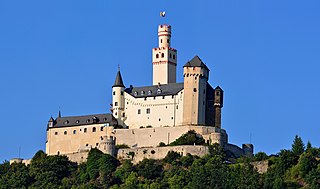
The Marksburg is a castle above the town of Braubach in Rhineland-Palatinate, Germany. It is one of the principal sites of the Rhine Gorge UNESCO World Heritage Site. The fortress was used for protection rather than as a residence for royal families. It has a striking example of a bergfried designed as a butter-churn tower. Of the 40 hill castles between Bingen am Rhein and Koblenz the Marksburg was one of only two which had never been destroyed and at least the only one that had never fallen into disrepair.
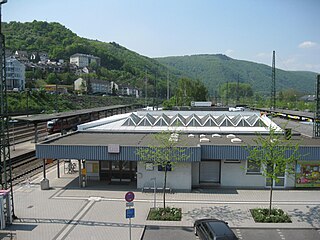
Bingen (Rhein) Hauptbahnhof is a railway station in the German city of Bingen am Rhein on the West Rhine Railway. It is located in the borough of Bingerbrück. The station that serves central Bingen is called Bingen Stadt.

Boppard Hauptbahnhof is a station in the town of Boppard in the German state of Rhineland-Palatinate. It is located on the outskirts of the town near the Rhine. It is at a railway junction on the West Rhine Railway between Köln Hauptbahnhof and Mainz Hauptbahnhof, and it is the starting point of the Hunsrück Railway (Hunsrückbahn) to Emmelshausen. It has three platform tracks.
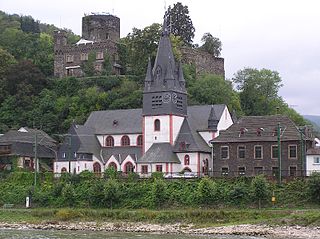
Niederheimbach is an Ortsgemeinde – a municipality belonging to a Verbandsgemeinde, a kind of collective municipality – in the Mainz-Bingen district in Rhineland-Palatinate, Germany.

Oberdiebach is an Ortsgemeinde – a municipality belonging to a Verbandsgemeinde, a kind of collective municipality – in the Mainz-Bingen district in Rhineland-Palatinate, Germany.

Trechtingshausen is an Ortsgemeinde – a municipality belonging to a Verbandsgemeinde, a kind of collective municipality – in the Mainz-Bingen district in Rhineland-Palatinate, Germany.

Rhine Castle trail - Rheinburgenweg, follows the left side of the Rhine from Bingen to Remagen-Rolandseck and the right side takes the route of the Rheinsteig from Rüdesheim am Rhein to Koblenz.

Reichenstein Castle, also known as Falkenburg is a castle in the UNESCO World Heritage Site of the Upper Middle Rhine Valley. It stands on a mountain spur on the eastern slope of the Bingen Forest, above the Rhineland-Palatinate municipality of Trechtingshausen in the Mainz-Bingen district in Germany.

Ehrenfels Castle is a ruined hillside castle above the Rhine Gorge near the town of Rüdesheim am Rhein in Hesse, Germany. It is located on the steep eastern bank of the river amid extended vineyards. The grape variety Ehrenfelser is named after the castle.
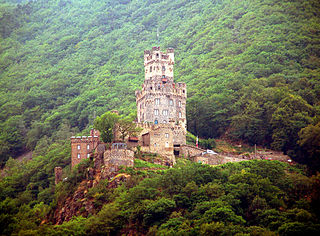
Sooneck Castle is a castle in the upper middle valley of the Rhine, in the Mainz-Bingen district of Rhineland-Palatinate, Germany. It is located near the village of Niederheimbach between Bingen and Bacharach.

The Rhine romanticism was the interpretation of the landscape conditions and history of the Rhine Valley in the cultural-historical period of the romanticism, by the end of the 18th century until the late 19th century and was continued in all forms of art expression.

Bingen (Rhein) Stadt station is, after Bingen Hauptbahnhof, the second largest station in the town of Bingen am Rhein in the German state of Rhineland-Palatinate. The station is located on the West Rhine Railway between Koblenz to Mainz. Furthermore, the station is the beginning and end of the Rheinhessen Railway to/from Worms. The station is classified by Deutsche Bahn as a category 4 station.

The Brömserburg is a castle located near the banks of the Rhine in the town of Rüdesheim am Rhein in Rheingau-Taunus-Kreis in the German state of Hesse. Its original structure was probably one of the first stone castles in the Rhine Gorge, now a UNESCO World Heritage Site.


























